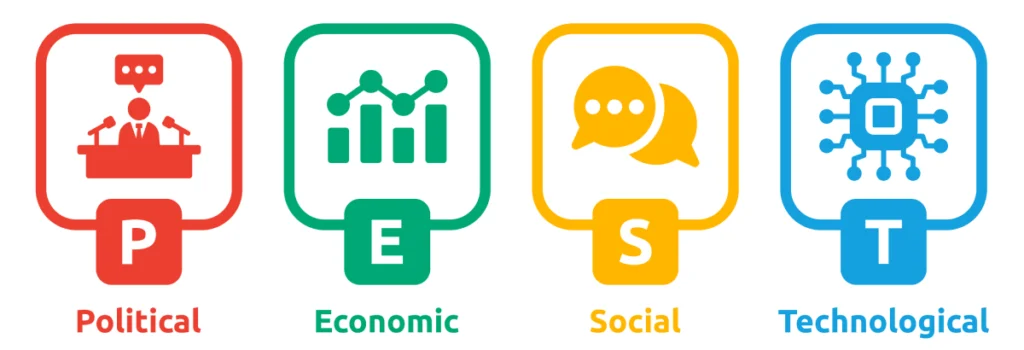PEST analysis is a strategic management tool used to analyze and evaluate the external macro-environmental factors that can impact an organization. The acronym PEST stands for Political, Economic, Social, and Technological factors. This analysis helps businesses understand and respond to the various factors that might influence their operations, decision-making processes, and overall success.
Table of Contents
ToggleWhat are the Key Factors of PEST Analysis?
- Political Factors: This includes the impact of government policies, regulations, and political stability on the business environment. Political factors may encompass tax policies, trade tariffs, labor laws, government stability, and other elements related to the political landscape.
- Economic Factors: Economic factors involve the influence of the broader economic conditions on an organization. Key considerations include inflation rates, exchange rates, economic growth or recession, interest rates, and overall economic stability.
- Social Factors: Social factors pertain to the societal and cultural influences that can affect an organization. Demographic trends, cultural attitudes and values, lifestyle changes, and social norms are examples of social factors.
- Technological Factors: Technological factors focus on the impact of technology on the industry or business. This can include innovations, research and development, automation, and the rate of technological change.
PEST analysis is a versatile tool and can be expanded to include additional factors like Environmental and Legal, resulting in a PESTEL or PESTLE analysis. The expanded analysis includes consideration of environmental sustainability issues and legal frameworks, providing a more comprehensive understanding of the external environment.
How to Conduct a PEST Analysis?
By conducting a PEST analysis, organizations can gain insights into the external factors that may present opportunities or pose threats. This analysis helps in strategic planning, risk management, and making informed decisions to navigate the complex business environment effectively.
PEST analysis can be done by following the steps below:
- Identify the factors. First, identify the factors to be analyzed. These factors will depend on the industry and market in which the business or product operates.
- Research the factors. Second, start researching each factor. Assess how these factors can affect the business or product.
- Evaluate the factors. Evaluate each factor, whether it is an opportunity or a threat to the business or product.
- Analyze the results. By analyzing the results, better understand the external environment of the business or product.

Examples of PEST Analysis
Since it is a complex subject, we will explain this analysis method to you with examples from global companies. You will be able to have a better understanding through the examples of Coca Cola Analysis and Turkish Airlines Analysis.
Turkish Airlines PEST Analysis Example
Turkish Airlines is the national airline of Turkey. Therefore, the company needs to consider the political, economic, social and technological factors in Turkey where it operates.
- Political factors: Turkish Airlines is affected by government policies and regulations. For example, if a new air transportation law is passed in a country, it may affect Turkish Airlines’ operations.
- Economic factors: Turkish Airlines is affected by economic growth. A slowdown in economic growth could reduce Turkish Airlines’ passenger numbers and revenue.
- Social factors: Turkish Airlines is affected by consumers’ lifestyles. For example, if consumers prefer to travel more, this could increase Turkish Airlines’ passenger numbers.
- Technological factors: Turkish Airlines is influenced by new technologies. For example, new flight technologies can make Turkish Airlines’ flights more efficient.
Coca Cola PEST Analysis Example
Coca Cola is a global beverage company. Therefore, the company needs to take into account political, economic, social and technological factors in all countries where it operates.
- Political factors: Coca Cola is affected by government policies and regulations. For example, if a new tax law is passed in a country, the cost of Coca Cola’s products may increase.
- Economic factors: Coca Cola is affected by economic growth. A slowdown in economic growth could reduce Coca Cola’s sales and profits.
- Social factors: Coca Cola is affected by consumers’ lifestyles. For example, a shift towards healthier diets could reduce Coca Cola’s sales of sugary drinks.
- Technological factors: Coca Cola is affected by new technologies. For example, new packaging technologies may make Coca Cola’s products more environmentally friendly.
Why Conduct a PEST Analysis?
Conducting a PEST analysis serves several crucial purposes for organizations seeking to understand and adapt to their external environment. Here are some key reasons why a PEST analysis is valuable:
Strategic Planning: PEST analysis is integral for organizations in identifying external factors influencing their strategies, goals, and decision-making processes.
Opportunities and Threats: By analyzing Political, Economic, Social, and Technological factors, organizations can pinpoint opportunities arising from environmental changes and identify potential threats to their operations.
Adapting to Change: PEST analysis offers a systematic approach for organizations to monitor and adapt to dynamic changes in the political, economic, social, and technological landscapes.
Risk Management: Understanding external factors aids effective risk assessment, enabling organizations to develop strategies to mitigate challenges resulting from environmental changes.
Informing Decision-Making: PEST analysis provides valuable insights guiding executives and managers in making informed decisions about investments, resource allocation, and strategic initiatives.
Market Research: In entering new markets, PEST analysis is crucial for understanding local, regional, or global factors impacting the success of products or services.
Scenario Planning: Organizations can use PEST analysis for scenario planning, developing alternative strategies to prepare for various future possibilities.
Competitive Advantage: Identifying external opportunities and threats helps organizations leverage strengths and address weaknesses, contributing to the development of a competitive advantage.
Government and Regulatory Compliance: Understanding political factors ensures compliance with government regulations, helping organizations anticipate and respond to legislative changes impacting operations.
What are the Differences between SWOT and PEST Analysis?
SWOT analysis and PEST analysis are both strategic management tools used to assess and understand various aspects of a business environment, but they focus on different aspects and provide different perspectives. Here are the key differences between SWOT and PEST analyses:
SWOT Analysis:
Scope:
Internal Focus: SWOT analysis examines internal factors within an organization, assessing Strengths, Weaknesses, Opportunities, and Threats.
Components:
Strengths and Weaknesses: Internal factors related to resources, capabilities, and performance.
Opportunities and Threats: External factors, assessed within the internal context.
Application:
Business-Specific: Applied at the business level to understand the current state and position within the industry.
Time Frame:
Current Situation: Provides insights into the present conditions of an organization.
PEST Analysis:
Scope:
External Focus: Examines macro-environmental factors—Political, Economic, Social, and Technological—that affect an organization.
Components:
Political, Economic, Social, and Technological Factors: Analyzes external influences without delving into internal strengths and weaknesses.
Application:
Industry and Market Context: Often applied at the industry or market level to understand broader environmental influences.
Time Frame:
Future Outlook: Forward-looking, considering potential future changes and trends in the external environment.
Integration:
Complementary Tools: SWOT and PEST analyses are often used together to provide a comprehensive strategic overview. SWOT focuses on internal factors, while PEST provides insights into the external environment.
Strategic Planning: Organizations integrate findings from both analyses for strategic planning. SWOT identifies internal factors to leverage or improve, while PEST identifies external factors to monitor or adapt to.
Different Perspectives: SWOT focuses on the immediate business environment, while PEST provides a broader perspective by considering factors beyond the organization’s control.
In summary, SWOT analysis is more internally focused, examining an organization’s strengths and weaknesses in its current state, while PEST analysis looks externally at the broader environmental factors that could impact the organization in the future. Both analyses, when used together, contribute to a more holistic understanding of an organization’s strategic position and potential avenues for improvement or adaptation.



